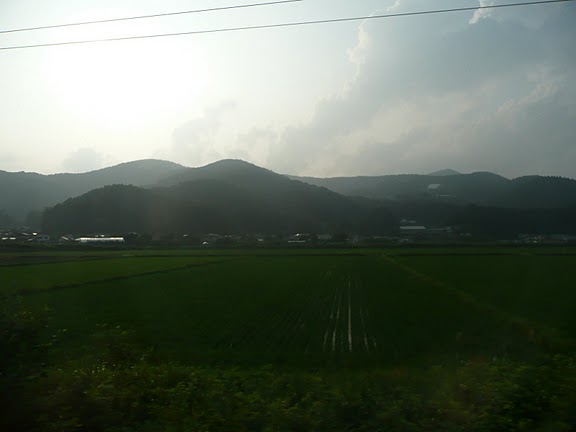A photo report of my first trip to Kanazawa in 2010. I stayed for two days.
 |
| Trein onderweg naar Kanazawa View from train on the way to Kanazawa |
Vanuit Tokyo (Shinagawa) gingen we via Maibara naar Kanazawa. Het is ongeveer 4,5 uur reizen, waarvan een groot gedeelte met de Shinkansen. Je kunt ook via Echigo-Yuzawa reizen, wat wat meestal net iets sneller is, maar omdat Shinagawa dichterbij was voor ons, scheelde het nauwelijks. In 2014 is de Shinkansen naar Kanazawa gereed, waardoor er een snelle, directe verbinding via Nagano zal zijn met een aanzienlijk kortere reistijd.
Na het inchecken in ons hotel en een snelle lunch, gingen we naar NagamachiFrom Tokyo (Shinagawa station) we went to Kanazawa via Maibara. It is about 4,5hrs of travel. You can also go through Echigo-Yuzawa, which is a bit faster if you start at Tokyo station. The Shinkansen will connect to Kanazawa in 2014 via Nagano, which will result in significantly reduced traveltime. After checking in to our hotel and a quick lunch, we went to Nagamachi
 |
| Nagamachi is een wijk met oude Samurai-huizen Nagamachi is an old Samurai district |
 |
| Veel huizen worden bewoond Many houses are inhabited |
Some houses are accessible as a museum or cafe.
 |
| Ingang van een van de huizen Entrance to one of the houses |
 |
| Tuin Surrounding garden |
The Nomura House was the most impressive. Particularly the garden was outstanding.
 |
| Ingang Nomura Residence Nomura Residence entrance |
 |
| Samurai Armor |
 |
| Derde plaats op een lijst met beste tuinen van Japan Third on a list of Japanese gardens |
 |
| Twee Michelin sterren (als toeristische attractie) Two Michelin stars (as a tourist attraction) |
Na ons bezoek aan Nomura's geweldige villa, bezoek aan een theehuis aan de overkant van de straat.
After our visit to the impressive Nomura Residence, we went to a tea house across the street.
After our visit to the impressive Nomura Residence, we went to a tea house across the street.
 |
| Japanse thee met traditionele zoeternij Japanese tea with traditional sweets |
 |
| Met uitzicht op een tuin A view on a garden included |
Hierna kwamen we langs Oyama Jinja, een Japanse schrijn uit de 16e eeuw ontworpen door een Nederlandse architect.
Next we passed by Oyama Jinja, a 16th century shrine designed by a Dutch architect.
Next we passed by Oyama Jinja, a 16th century shrine designed by a Dutch architect.
 |
| Ema, houten wenspanelen Ema, wooden wishing plaques |
Eerlijk gezegd niet echt speciaal vergeleken met de tempels in bijvoorbeeld Kyoto. Het hotel waar we verbleven is inmiddels gesloten, dus daarover geen verslag.
To be honest, not as special as shrines in Kyoto. The hotel we stayed at has been closed down since, so no report on the hotel.












